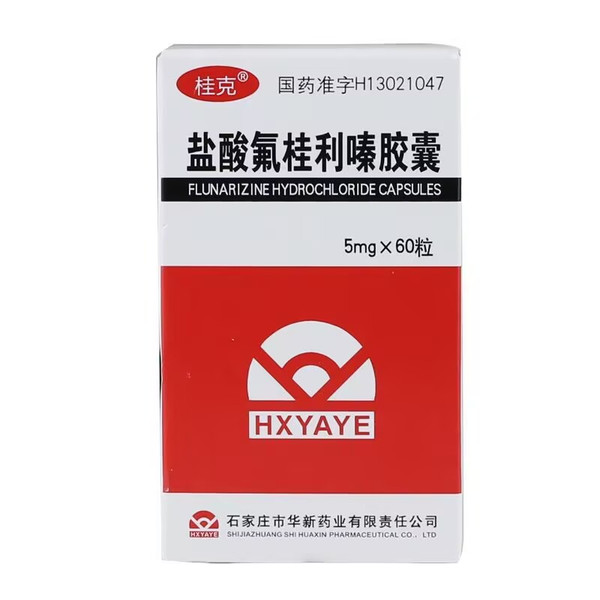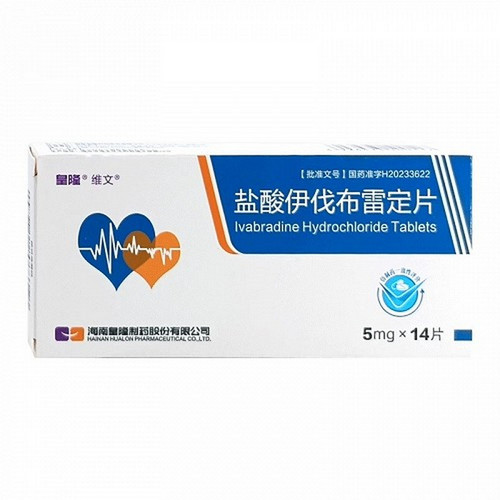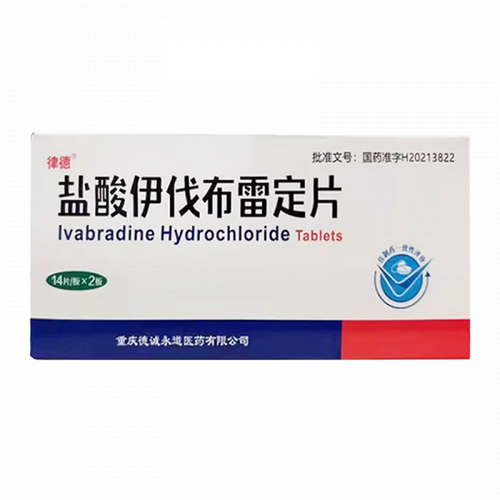Product Overview
[Drug Name]
Generic Name: Flunarizine Hydrochloride Capsules
Trade Name: Gui Ke
English Name: Flunarizine Hydrochloride Capsules
Chinese Pinyin: Yan suan fu gui li qin jiao nang
[Ingredients]
Mainly contains flunarizine
[Properties]
This product is a capsule
[Indications]
(1) Insufficient cerebral blood supply, vertebral artery ischemia, cerebral thrombosis, etc.
(2) Tinnitus, dizziness.
(3) Prevention of migraine.
(4) Adjunctive treatment of epilepsy.
[Usage and Dosage]
(1) For central vertigo and peripheral vertigo, including vertebrobasilar artery insufficiency, use flunarizine 10-20 mg per day, 2-8 weeks as a course of treatment.
(2) For idiopathic tinnitus, use flunarizine 10 mg once a night, 10 days as a course of treatment.
(3) For intermittent claudication, use flunarizine 10-20 mg per day.
(4) For migraine prevention, take 5-10 mg of flunarizine twice daily.
(5) For cerebral arteriosclerosis and cerebral infarction recovery period, take 5-10 mg of flunarizine daily.
[Adverse Reactions]
(1) Adverse reactions of the central nervous system include: ① Drowsiness and fatigue are the most common. ② Depression may occur in long-term users, which is more common in female patients. ③ Extrapyramidal symptoms, such as involuntary movements, mandibular dyskinesia, and rigidity. Most of them appear after 3 weeks of medication and disappear after discontinuation. They are more likely to occur in the elderly. ④ A small number of patients may experience insomnia, anxiety, and other symptoms.
(2) Gastrointestinal symptoms include: burning sensation in the stomach, hyperphagia, increased food intake, and weight gain.
(3) Others: A small number of patients may experience rash, dry mouth, galactorrhea, muscle aches, and other symptoms. However, these symptoms are mostly transient and can be relieved by discontinuation of the drug.
[Contraindications]
This drug is contraindicated if there is a history of allergy to this drug or a history of depression. It is contraindicated for use in patients with acute cerebral hemorrhage.
[Precautions]
(1) If fatigue symptoms gradually worsen after taking the drug, the dosage should be reduced or the drug should be stopped.
(2) Strictly control the dosage of the drug. When the maintenance dose does not achieve the therapeutic effect or extrapyramidal symptoms appear after long-term use, the dosage should be reduced or the drug should be stopped. (3) This preparation should be used with caution in patients with extrapyramidal diseases such as Parkinson's disease. (4) Since this preparation can be secreted with breast milk, although there are no research reports on teratogenicity and effects on embryonic development, in principle, pregnant and lactating women should not use this drug.
(5) Drivers and machine operators should use it with caution to avoid accidents.
[Use in special populations]
Precautions for children:
Since this drug can pass through the blood-brain barrier, it has clear adverse reactions in the central nervous system and the central nervous system of children is sensitive to the drug; its metabolic function is relatively weak. Although there is currently no detailed research data on its use in children, in principle, children should use this drug with caution or avoid it.
Precautions during pregnancy and lactation:
Since this drug can pass through the placenta and be secreted in breast milk, although there are no reports of teratogenicity or effects on embryonic development, in principle, pregnant and lactating women should not use this drug.
Precautions for the elderly:
Since the nervous system of elderly patients is more sensitive and their metabolic capacity is weaker, the dosage should be reduced as appropriate.
[Drug Interactions]
(1) When used in combination with alcohol, hypnotics or sedatives, the sedative effect is aggravated.
(2) When used in combination with phenytoin sodium or carbamazepine, the blood concentration of flunarizine can be reduced.
(3) When used in combination with cinnarizine in patients undergoing radiotherapy, it can increase the killing power of tumor cells.
(4) Adding flunarizine to anti-epileptic drug treatment can improve the anti-epileptic effect.
[Pharmacological Actions]
This product is a calcium channel blocker. It can prevent cell damage caused by pathological intracellular calcium overload due to ischemia and other reasons. This product has the following effects: (1) Relieve vasospasm, and has a lasting inhibitory effect on persistent vasospasm caused by vasoconstrictor substances, especially on the basilar artery and internal carotid artery. Its effect is 15 times stronger than that of ceramide; (2) Vestibular inhibitory effect, which can increase blood flow in the cochlear arterioles and improve vestibular organ circulation; (3) Anti-epileptic effect, this product can block the pathological calcium overload of nerve cells and prevent paroxysmal depolarization and cell discharge, thereby avoiding epileptic seizures; (4) Protect the myocardium and significantly reduce ischemic myocardial damage; (5) Flunarizine also has the effect of improving renal function and can be used for chronic renal failure; In addition, this product also has antihistamine effect. Storage: Sealed, light-proof
Specifications: 5 mg (as C₂₆H₂₆F₂N₂)
Packaging: Aluminum foil and polyvinyl chloride solid tablets for pharmaceutical packaging, 5 mg x 60 seconds per bottle
Expiry Life: 36 months
Approval Number: National Medicine Standard H13021047
Manufacturer: Shijiazhuang Huaxin Pharmaceutical Co., Ltd.








